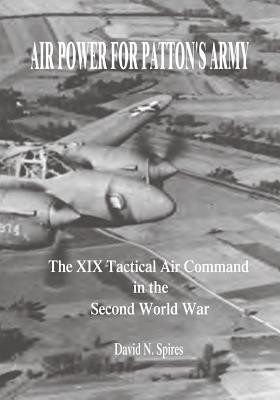
- We will send in 10–14 business days.
- Author: David N Spires
- Publisher: CreateSpace Independent Publishing Platform
- ISBN-10: 1515269019
- ISBN-13: 9781515269014
- Format: 17.8 x 25.4 x 2.1 cm, minkšti viršeliai
- Language: English
- SAVE -10% with code: EXTRA
Reviews
Description
"Air Power for Patton's Army" is a case study of one air-ground team's experience with the theory and practice of tactical air power employed during the climactic World War II campaigns against the forces of Nazi Germany. By the summer of 1944, the Allies had four fighter-bomber tactical air commands supporting designated field armies in northwest Europe, and in the fall they added a fifth (making four American and one British). Of these, the U.S. Third Army commanded by Lt. Gen. George S. Patton and the XIX Tactical Air Command (TAC) led by Brig. Gen. Otto P. Weyland deserve special attention as perhaps the most spectacular air-ground team of the Second World War on the Allied side. From the time Third Army became operational on August 1, 1944, until the guns fell silent on May 8, 1945, Patton's troops covered more ground, took more enemy prisoners, and suffered more casualties than any other Allied army in northwest Europe. General Weyland's XIX TAC was there every step of the way: in the high summer blitzkrieg across France to the Siegfried Line, in the battle of attrition and positional warfare in Lorraine reminiscent of World War One's western front, in the emergency drive to rescue American troops trapped at Bastogne and help clear the Ardennes of Germans in the Battle of the Bulge, and finally, in crossing the Rhine and charging across southern Germany to the Czech and Austrian borders. There, Third Army forces linked up with Soviet military units converging on the fabled German Redoubt area from the east.
EXTRA 10 % discount with code: EXTRA
The promotion ends in 21d.14:41:40
The discount code is valid when purchasing from 10 €. Discounts do not stack.
- Author: David N Spires
- Publisher: CreateSpace Independent Publishing Platform
- ISBN-10: 1515269019
- ISBN-13: 9781515269014
- Format: 17.8 x 25.4 x 2.1 cm, minkšti viršeliai
- Language: English English
"Air Power for Patton's Army" is a case study of one air-ground team's experience with the theory and practice of tactical air power employed during the climactic World War II campaigns against the forces of Nazi Germany. By the summer of 1944, the Allies had four fighter-bomber tactical air commands supporting designated field armies in northwest Europe, and in the fall they added a fifth (making four American and one British). Of these, the U.S. Third Army commanded by Lt. Gen. George S. Patton and the XIX Tactical Air Command (TAC) led by Brig. Gen. Otto P. Weyland deserve special attention as perhaps the most spectacular air-ground team of the Second World War on the Allied side. From the time Third Army became operational on August 1, 1944, until the guns fell silent on May 8, 1945, Patton's troops covered more ground, took more enemy prisoners, and suffered more casualties than any other Allied army in northwest Europe. General Weyland's XIX TAC was there every step of the way: in the high summer blitzkrieg across France to the Siegfried Line, in the battle of attrition and positional warfare in Lorraine reminiscent of World War One's western front, in the emergency drive to rescue American troops trapped at Bastogne and help clear the Ardennes of Germans in the Battle of the Bulge, and finally, in crossing the Rhine and charging across southern Germany to the Czech and Austrian borders. There, Third Army forces linked up with Soviet military units converging on the fabled German Redoubt area from the east.


Reviews